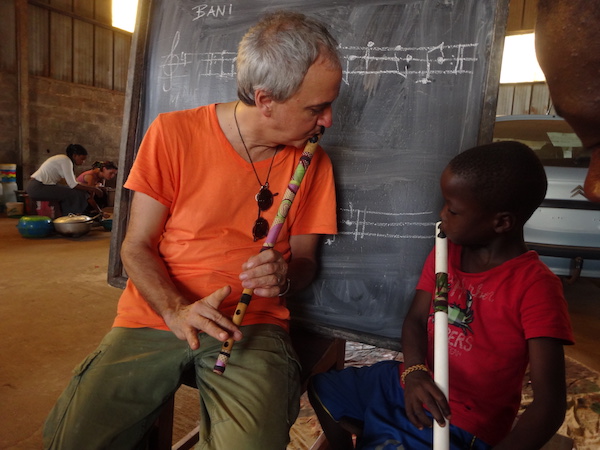Dec 9, 2025 12:28 PM
In Memoriam: Gordon Goodwin, 1954–2025
Gordon Goodwin, an award-winning saxophonist, pianist, bandleader, composer and arranger, died Dec. 8 in Los Angeles.…

Sylvain Leroux helms L’Ecole Fula Flute, an alternative school in Guinea that aims to teach students from ages 6 to 20 academic fundamentals, as well as music.
(Photo: L’Ecole Fula Flute)In a cinderblock schoolhouse with a corrugated tin roof in Conakry, Guinea, reeds specialist Sylvain Leroux is opening new horizons of musical literacy for more than two dozen young students—and future generations.
Seven years ago, having made a simple but inspired modification to the age-old three-holed flute of the West African Fula (or Peul) people, Montreal-born, New York City-based Leroux instituted a free training program in a country mostly lacking formal arts education.
Thanks to his Kickstarter fund-raising efforts, production of two albums—Les Enfants de Tyabala (2014) and Tyabala (2019)—and multiple videos, Leroux’s L’Ecole Fula Flute has become an alternative school with a staff of eight. Its mission is to teach boys and girls from ages 6 to 20 academic fundamentals, as well as how to approach the entire 12-note chromatic scale of Western music on an instrument previously capable of producing a more limited number of pitches.
“It’s a hollow vine,” Leroux said of the material from which he has hand-crafted both traditional models and the six-holed chromatic tambin he’s developed and patented. “You have to go into the bush to harvest it. They grow like cones in marshes along the Niger River, with dangerous barbs and snakes nesting in them.”
Typically about two feet long, decorated with shells and very lightweight, the transversely blown tambin has an embouchure made of a beeswax substance. It presents conceptual and technical challenges.
“The Fula flute that works best is pitched to F,” Leroux explained, “but balafons are always in C, so there would be an issue with B-flat. I’d use half-hole [fingering techniques] or fake it, but one day I looked at an A-flat flute and realized if I moved the holes and added some more I might have the whole thing. I tried it, and I was right. This was in 2011. I’d been playing Fula flute since 1995, when I first went to Guinea, so this blew my mind. And it became the genesis of the school.”
Conakry musicians led Leroux to a government-funded community organization willing to try his idea. After being there for three weeks, then four months, he realized he couldn’t stay year-round, so he enlisted other teachers. L’Ecole Fula Flute now offers training six days a week, 8 a.m. to 6 p.m., in percussion, kora, acting, dancing, songwriting and arranging besides traditional and chromatic tambin, and academic topics. When engaged in fundamentals, pupils sit at desks. When learning music, they gather on a slightly raised stage in the round.
Back home in New York, Leroux has played tambin in Karl Berger’s Creative Music Orchestra and with Guinean ex-pat Bailo Bah, a Fula flute virtuoso. And he’s recently organized a quartet with a percussionist who doubles on balafon, an electric bassist and an accordionist, for cross-cultural purposes.
“I want to play standards and some classical music on the Fula flute, so people can see if they can accept the sound of it with music that’s familiar,” said Leroux. “Some people in the intelligentsia love the Fula flute’s sound and tradition, but when they hear Bach or Monk on it, they think it’s been denatured. African people don’t have that reaction—on the contrary.” DB

Goodwin was one of the most acclaimed, successful and influential jazz musicians of his generation.
Dec 9, 2025 12:28 PM
Gordon Goodwin, an award-winning saxophonist, pianist, bandleader, composer and arranger, died Dec. 8 in Los Angeles.…

Nov 13, 2025 10:00 AM
For results of DownBeat’s 90th Annual Readers Poll, complete with feature articles from our December 2025 issue,…

Flea has returned to his first instrument — the trumpet — and assembled a dream band of jazz musicians to record a new album.
Dec 2, 2025 2:01 AM
After a nearly five-decade career as one of his generation’s defining rock bassists, Flea has returned to his first…

To see the complete list of nominations for the 2026 Grammy Awards, go to grammy.com.
Nov 11, 2025 12:35 PM
The nominations for the 2026 Grammy Awards are in, with plenty to smile about for the worlds of jazz, blues and beyond.…

Drummond was cherished by generations of mainstream jazz listeners and bandleaders for his authoritative tonal presence, a defining quality of his style most apparent when he played his instrument unamplified.
Nov 4, 2025 11:39 AM
Ray Drummond, a first-call bassist who appeared on hundreds of albums as a sideman for some of the top names in jazz…








